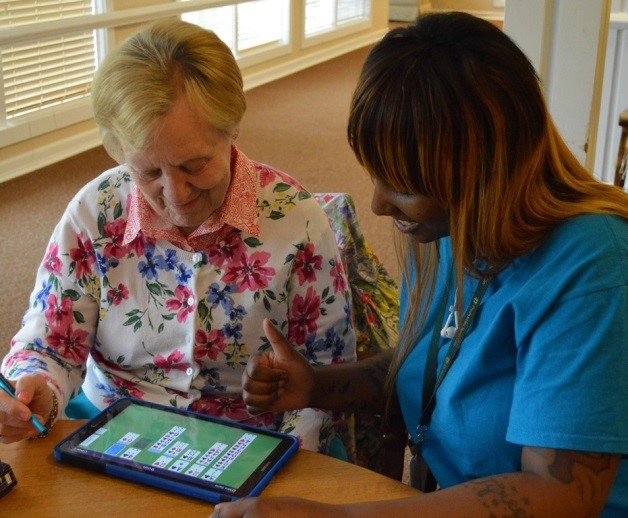SEEING RE2D
by Carrie Chiusano, Presbyterian SeniorCare Network
 Presbyterian SeniorCare Network is dedicated to work that furthers our understanding of aging, which enables us to create better programs and services. Research is an important part of our effort to meet the needs of the people we serve.
Our Dementia Care Center of Excellence wanted to embark upon research that examined the benefits of technology usage in rehabilitation therapy for residents living with moderate to severe dementia. The study, Rehabilitation Effectiveness and Efficiency in Dementia Care (RE2D), compared whether It’s Never 2 Late® (iN2L) touch-screen technology would help increase engagement and participation in therapy for residents who are living with cognitive difficulties.
Presbyterian SeniorCare Network has partnered with iN2L for close to 15 years and knows first-hand how the systems help the team, help residents, engage in their own person – centered interests.
We asked Steven Zarit, PhD, Distinguished Professor Emeritus of Penn State University and Research Advisor to Presbyterian SeniorCare Network’s Dementia Care Center of Excellence, to lead us on our research journey.
Our study used the iN2L systems to see if engaging stimuli, such as cognitive games, physical games, music and videos … just to name a few … would make rehabilitative therapy more interesting for residents and increase their participation enough to make a positive difference. The study called for two research assistants and our team of rehabilitation therapists to observe and rate the amount of engagement of each participant, based on a standardized scoring system called the Pittsburgh Rehabilitation Participation Scale. Residents were rated on the scale at the start of therapy and again after roughly 20 therapy sessions.
The researchers followed about 100 individuals in two communities, 45 miles from each other. All received occupational and physical therapy for 10 to 14 days, typically after a hospital stay. The control group consisted of 50 residents at the Southmont Rehabilitation Community on our Washington campus. Those residents received the regular rehabilitation regime of therapy without the use of the iN2L technology. The test group of 50 residents at The Willows on the Oakmont campus received rehabilitation therapy incorporating the iN2L technology with therapists using the touchscreen system to incorporate activity personalized to the residents’ interests.
When a resident “colored” an onscreen picture, for example, the therapist might raise the artwork higher to encourage higher arm positioning. Before you knew it, they were painting with their arm above their original goal height without even realizing it. In another case, a resident who loved airplanes moved from frustration to full participation when working with a flight simulation game.
The technology adds to therapists’ clinical toolbox, helping them gain the attention of persons living with dementia and engage them more effectively.
The results suggest that technology-inspired engagement drove better outcomes. Investigators found that participants who used the technology had significantly higher goal attainment than their peers who did not.
Presbyterian SeniorCare Network is currently expanding the technology into its rehabilitation program across the Network.Full findings were published in the journal Aging and Mental Health: https://www.tandfonline.com/doi/full/10.1080/13607863.2020.1711864
Presbyterian SeniorCare Network is dedicated to work that furthers our understanding of aging, which enables us to create better programs and services. Research is an important part of our effort to meet the needs of the people we serve.
Our Dementia Care Center of Excellence wanted to embark upon research that examined the benefits of technology usage in rehabilitation therapy for residents living with moderate to severe dementia. The study, Rehabilitation Effectiveness and Efficiency in Dementia Care (RE2D), compared whether It’s Never 2 Late® (iN2L) touch-screen technology would help increase engagement and participation in therapy for residents who are living with cognitive difficulties.
Presbyterian SeniorCare Network has partnered with iN2L for close to 15 years and knows first-hand how the systems help the team, help residents, engage in their own person – centered interests.
We asked Steven Zarit, PhD, Distinguished Professor Emeritus of Penn State University and Research Advisor to Presbyterian SeniorCare Network’s Dementia Care Center of Excellence, to lead us on our research journey.
Our study used the iN2L systems to see if engaging stimuli, such as cognitive games, physical games, music and videos … just to name a few … would make rehabilitative therapy more interesting for residents and increase their participation enough to make a positive difference. The study called for two research assistants and our team of rehabilitation therapists to observe and rate the amount of engagement of each participant, based on a standardized scoring system called the Pittsburgh Rehabilitation Participation Scale. Residents were rated on the scale at the start of therapy and again after roughly 20 therapy sessions.
The researchers followed about 100 individuals in two communities, 45 miles from each other. All received occupational and physical therapy for 10 to 14 days, typically after a hospital stay. The control group consisted of 50 residents at the Southmont Rehabilitation Community on our Washington campus. Those residents received the regular rehabilitation regime of therapy without the use of the iN2L technology. The test group of 50 residents at The Willows on the Oakmont campus received rehabilitation therapy incorporating the iN2L technology with therapists using the touchscreen system to incorporate activity personalized to the residents’ interests.
When a resident “colored” an onscreen picture, for example, the therapist might raise the artwork higher to encourage higher arm positioning. Before you knew it, they were painting with their arm above their original goal height without even realizing it. In another case, a resident who loved airplanes moved from frustration to full participation when working with a flight simulation game.
The technology adds to therapists’ clinical toolbox, helping them gain the attention of persons living with dementia and engage them more effectively.
The results suggest that technology-inspired engagement drove better outcomes. Investigators found that participants who used the technology had significantly higher goal attainment than their peers who did not.
Presbyterian SeniorCare Network is currently expanding the technology into its rehabilitation program across the Network.Full findings were published in the journal Aging and Mental Health: https://www.tandfonline.com/doi/full/10.1080/13607863.2020.1711864 
